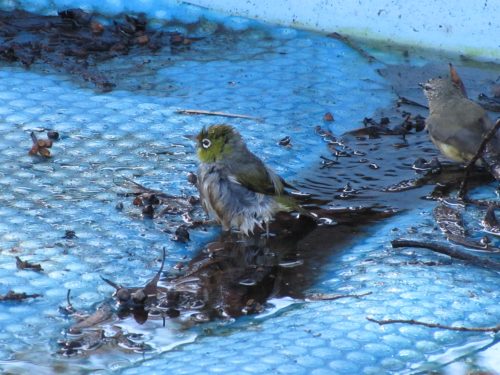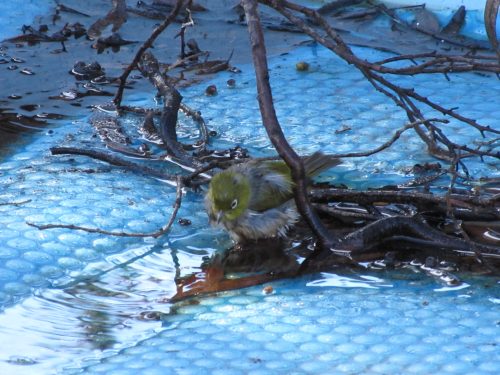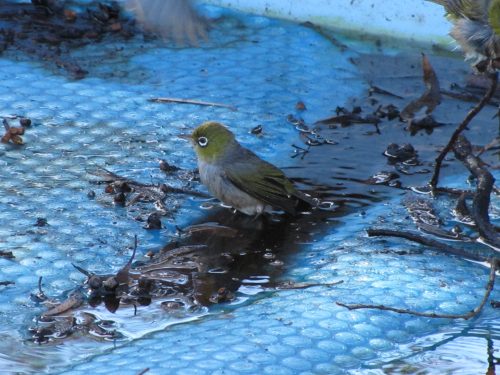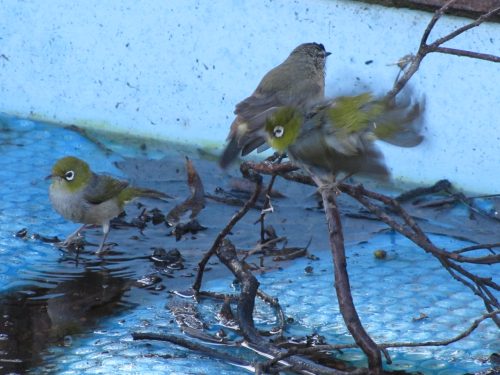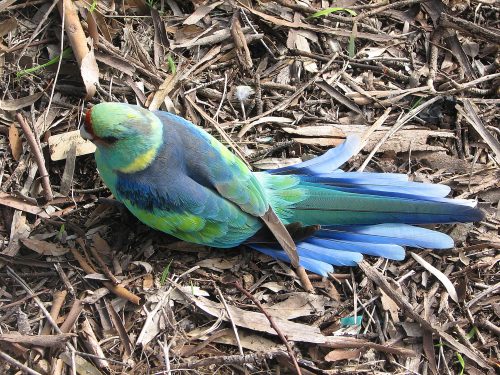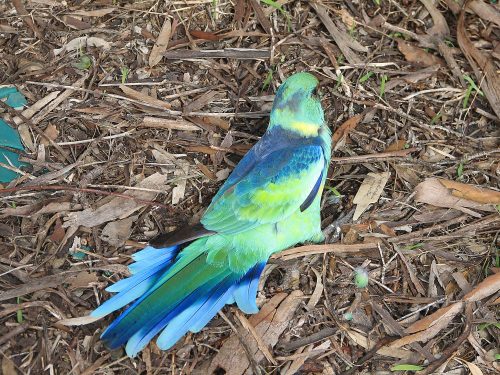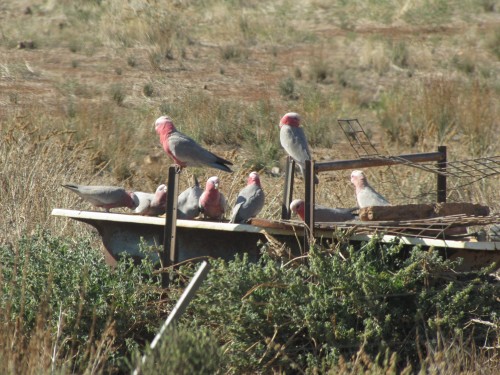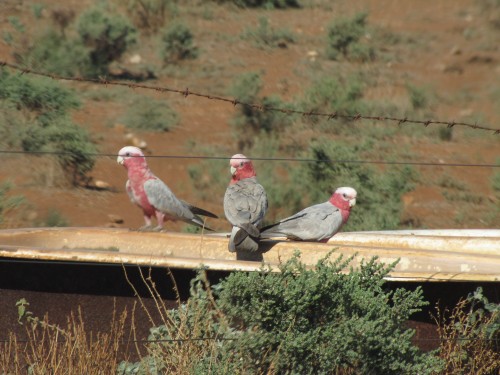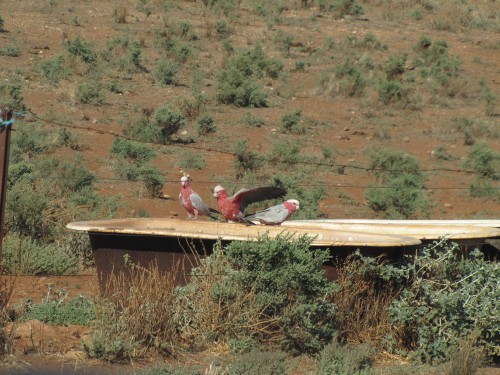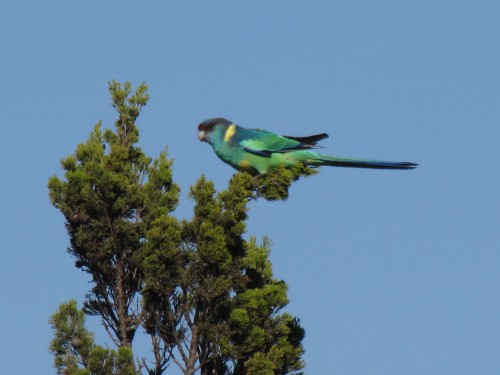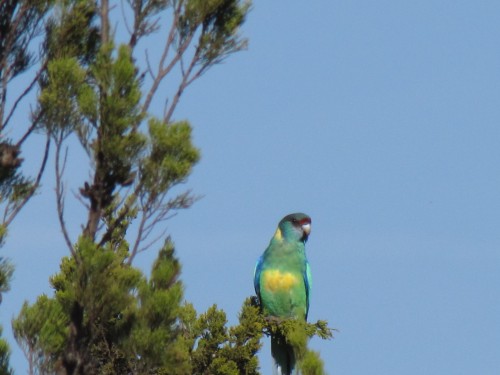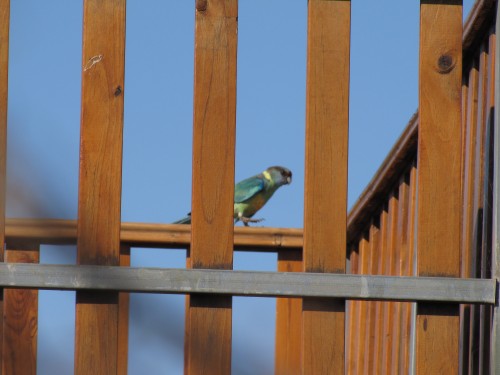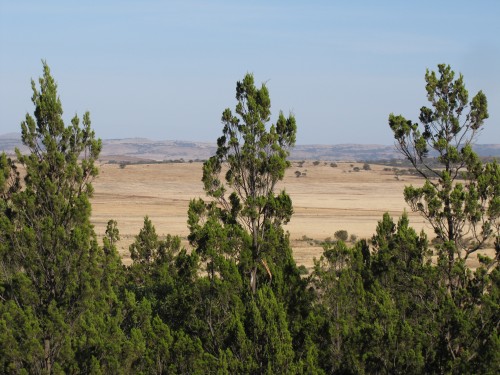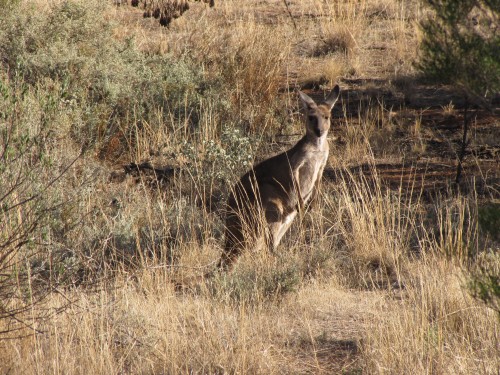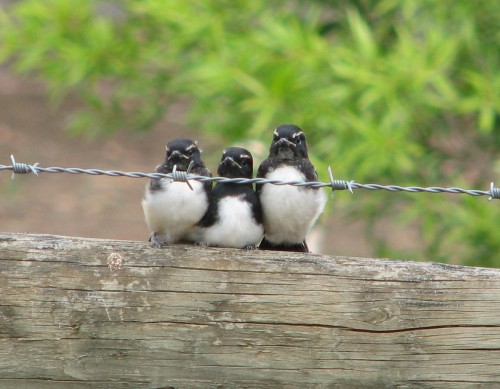Silvereyes come for a bath
In my last article here I posted some photos of Yellow-rumped Thornbills bathing in the small pools of water which gather after rain on our swimming pool solar blanket. On the same day, a small number of Silvereyes also came for a drink and to bathe. I have shown these in today’s post.
Our swimming pool is in our backyard, a short distance from our back veranda. On nice sunny days when it is not too hot in the middle of summer, or not too cold in the middle of winter, we enjoy sitting on the veranda to have our lunch. Sometimes we take a mid-morning break there for a cup of tea or coffee. We have also taken an afternoon break when gardening.
On all of these occasions, we enjoy the constant parade of birds in our garden, perched on the fence or in the trees nearby, and on the pool cover like the Silvereyes shown today. I often have my binoculars and camera at the ready while we sit there. On this occasion, I managed to get many photos of the Silvereyes and the Yellow-rumped Thornbills. A Grey Fantail was also fluttering around, but you will have to return in a few days’ time to see those photos in my next post.
The water that gathers on our swimming pool cover in the winter and spring months are visited by many birds over the course of each day. In addition to the species I have already mentioned, another frequent visitor is the Magpie Lark. Both the male and the female come on a daily basis, often perching on the pool safety fence and calling loudly, their antiphonal singing a delight to hear. (Antiphonal: when the two birds sing a duet in parts.)
Our resident Australian White-backed Magpies also come to drink, and the bossy Red Wattlebirds will chase the smaller birds off. White-plumed Honeyeaters flit in and out nervously, while the Peaceful Doves take their time, gradually getting closer and closer until they gather the courage to stoop and drink. The Crested Pigeons also come for a drink, though they are usually more interested in mating displays than drinking.
The Welcome Swallows occasionally swoop low over the pool but more often they are seen much higher in the air. The many House Sparrows and Common Starlings come frequently to drink and bathe, but the resident Mallee Ringnecks rarely do so; they prefer to feed in the nearby trees. The Willie Wagtails, however, are frequent visitors to this part of the garden.
As you can see, it is never boring in our garden if you are a birder like myself.
Good birding,
Trevor
PS: Over the years, I have written articles about all of the birds mentioned in this article. To see photos of them, and to read more about each of them, use the search facility in the top right-hand corner of any page.
Beautiful Mallee Ringneck Parrots
Over recent years we have had a family of Australian Ringneck parrots move into our garden. Before that, they were only occasional visitors, but now we see – or hear – them every day. They can be raucous at times. I now consider them to be a resident breeding species in our garden. In fact, only last week I witnessed two of them mating, so we could have even more around in the next few months. They have been constantly investigating a large hollow in one of our mallee trees. The birds we have here are the sub-species Mallee Ringnecks.
At first, we only had two birds, but after breeding, there were more, and now we often count up to about eight birds in our garden, or in the nearby mallee scrub. They chatter away noisily in the nearby trees, often disturbing the peacefulness of our edge of town block of land. We don’t really mind because we love having them around. That is – until they attack our ripening pears, chewing around the stems of each piece of fruit. Each summer I have to drape netting over the trees to minimise the damage.
Last week I was going out the sliding door on to our back veranda. I was heading out to sit in the weak winter sun to do some reading. One of the parrots flew from the nearby tree towards the house just as I came out of the door. It was flying directly towards me, wings and tail spread out fan-like as it came to a stop, landing on the edge of the roof guttering. As the feathers spread out, I glimpsed the beautiful colours of this lovely bird. Sadly, I didn’t have my camera – it happened far too quickly, anyway.
The photo at the top of this post shows the colourful feathers of one of our birds which accidentally flew into my office window last year. It sat on the ground quite stunned for a few minutes before flying off again. The photo below shows another shot of the same bird.
Further reading:
A bunch of thirsty Galahs
In my post a few days ago I posted several photos of several Mallee Ringnecks taken just north of Peterborough in the mid-north of South Australia. As I left the reserve where I took those photos, I drove slowly along the dirt road back towards the town. I stopped several times to take a few photos of the local birds.
This was early in March and we were having a particularly hot spell of weather. By the time I had left the nature reserve, the air was beginning to really heat up. I thought that it might be prudent to head back to my brother-in-law’s home and lay low during the worst of the heat. On my way home, I spotted several small flocks of Galahs having a drink at several old baths in the nearby paddocks. The local farmers had placed these bath tubs in their horse paddocks, brought the water pipe to the bathtubs, installed floats and thus provided a water source for their horses and sheep.
Naturally, the Galahs have endorsed this installation by also indulging in an early morning drink before the heat of the day to come. The second photo (the one immediately below) is unfortunately spoiled by the thin line of the fencing wire passing across the face of two of the birds. I did not notice this when taking the photo. It was only when I downloaded the photo and enlarged it on my computer that I noticed the wire. Such are the hazards of photography.
A very noisy Mallee Ringneck
On the first weekend of March earlier this year my wife and I travelled to Peterborough in the mid-north of South Australia. My wife was attending a quilting seminar and we stayed with family while there. While she was attending the seminar I did a few hours of birding around town before the day became too hot.
The first place I ventured to was the Greg Duggan Reserve on Lookout Hill on the northern outskirts of town. This lookout gives a great view in all directions over the adjacent farming country surrounding the town. This small reserve is also a fine retreat for some of the local birds with over 70 species having been recorded there over the years. I had a good look around and managed a few good photos of a Western Grey Kangaroo (see photo below).
As I was leaving the lookout, which has a good ramp with wheelchair access, I heard the unmistakable and noisy call of a Mallee Ringneck Parrot. With very little effort I tracked it down and managed a few good photos which I have shown above and below. Next thing this bird was joined in a noisy duet with another bird which was walking along the railing of the lookout (see photo below). This chorus continued for several minutes before both birds flew off towards the town.
On our property in Murray Bridge, we have a noisy family of Mallee Ringneck parrots which are a resident breeding species in our garden. We get a little annoyed with them when they nibble at our pears as they are ripening on the trees. Mallee Ringnecks are a widespread species in the drier mallee areas of Australia. The Mallee Ringnecks are a sub-species of the Australian Ringneck, a widespread species with several other sub-species.
For more about the fauna of the Greg Duggan Reserve in Peterborough read my article called The Wildlife in the Greg Duggan Nature Reserve.
It’s nesting time again
It’s that time of year again in Australia – spring nesting season.
Birds everywhere are making nests, sitting on eggs in nests or feeding young just out of the nest. In southern Australia – the region I am most familiar with – the “spring” nesting season stretches from the winter months of July and August, through the entire season of spring (September – November) and even well into summer (December – January).
Having confused all of my overseas readers I should explain three things:
- Most of the breeding occurs in the spring months.
- Some species – like our honeyeaters – will nest multiple times, raising 2 or more broods a season.
- Some species will even raise as many as five broods over a six month period.
Being late September nesting is in full swing here on our 5 acre (2 hectare) property in Murray Bridge, South Australia. The following is a quick annotated list of those species I have observed in the breeding mode in recent weeks:
Willie Wagtail: our resident birds have been very quiet and I suspected that they had a nest somewhere but I only found it yesterday. It contained two eggs. The photo above shows a fluffy family of Willie Wagtails just out of the nest a few years ago.
New Holland Honeyeater: last week I saw two parent birds fussing over and feeding two fledglings just out of the nest and barely able to flutter, let alone fly.
Red Wattlebird: I saw one bird sitting on a nest high in one of our trees but haven’t checked it in recent days. Other wattlebirds in our garden are being bossier than usual, so I guess that there are young around somewhere.
House Sparrow (introduced species): they always seem to be mating and nesting, so nothing unusual there.
Common Starling (introduced): the resident dozen or so birds all seem to have taken up occupation of a number of tree hollows in our mallee scrub, but I haven’t yet heard the persistent calls of the nestlings begging to be fed.
Mallee Ringneck parrots: our resident birds were feeding young a month or so ago, and I have seen them constantly investigating a tree hollow. Earlier this week we saw two of them mating, so the next brood could be on the way soon.
Cuckoos: I haven’t seen any cuckoos yet this season but I have heard Horsfield’s Bronze-cuckoos calling several times, so they could possibly be nesting too.
Galah: I’m not sure what our Galahs are doing. They come to a hollow in an old growth mallee tree near our clothes line and enter the hollow every day but nothing else seems to be happening. This has happened now for several years so I will just have to keep an eye on proceedings.
Australian Magpie: this is a really puzzling one. The resident magpies showed all the right activities a few months ago when they defended their territory but since then everything has gone quiet. We daily see several birds feeding around the garden and in the paddock, but I have yet to locate a nest. Very strange.
I have highlighted just 9 species in this article. Over the last 30 years I have observed many more species either breeding, or feeding young, on our property. I am quite confident that there would be other species currently nesting somewhere here, possibly including:
- Grey Shrike-thrush
- Common Blackbird (introduced)
- Spotted Turtledove (introduced)
- Crested Pigeon
- Yellow-rumped Thornbill
- Weebill
- Spotted Pardalote
- Striated Pardalote
- Mistletoebird
- White-plumed Honeyeater
- Spiny-cheeked Honeyeater
- Singing Honeyeater
- Little Raven
- Pacific Black Duck (they bring the ducklings to our swimming pool!
- Superb Fairy-wren
- Australian Magpie-lark
- Grey Butcherbird
Further reading:
Click on the following article headings to read about successful breeding attempts in past years:
- We have baby Willie Wagtails
- New Holland Honeyeater nest
- Red wattlebirds with young
- House Sparrows eating berries
- Very Common Starlings – nesting
- Mallee Ringnecks nesting
- Horsfield’s Bronze-cuckoo
- Possible Galah nesting attempt
- Baby Magpie – this is the most popular article on this site with nearly 500 reader comments.
